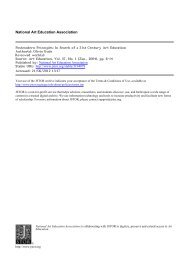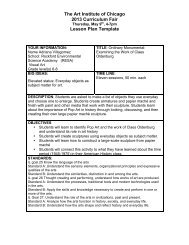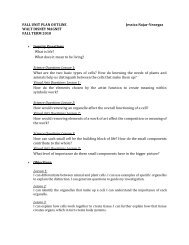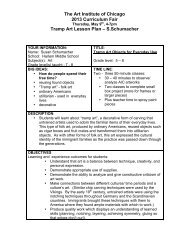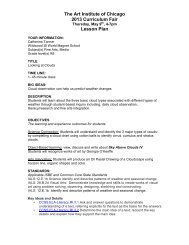Lesson Plan: Using Decorative Paper and Collage to Illustrate ...
Lesson Plan: Using Decorative Paper and Collage to Illustrate ...
Lesson Plan: Using Decorative Paper and Collage to Illustrate ...
You also want an ePaper? Increase the reach of your titles
YUMPU automatically turns print PDFs into web optimized ePapers that Google loves.
<strong>Lesson</strong> <strong>Plan</strong>: <strong>Using</strong> <strong>Decorative</strong> <strong>Paper</strong> <strong>and</strong> <strong>Collage</strong> <strong>to</strong> <strong>Illustrate</strong> Nature<br />
Grade Level: 1–5<br />
Estimated Time: 2–3 class sessions<br />
Curriculum Connections: Art, Science, Library<br />
Introduction<br />
Steve Jenkins writes <strong>and</strong> illustrates non-fiction picture books. This lesson focuses on the<br />
works of Steve Jenkins as a model for how picture books connect text <strong>and</strong> illustrations when<br />
informing about a variety of animals within a theme. Students will study Jenkins’ paper collage<br />
illustrations by referencing some of his books about animals. Students will then use the same<br />
collage technique <strong>to</strong> create their own animal illustrations based on individual research.<br />
<strong>Lesson</strong> Objectives:<br />
Students will be able <strong>to</strong>:<br />
• become familiar with the work of Steve Jenkins<br />
• identify the roles of the author <strong>and</strong> illustra<strong>to</strong>r<br />
• underst<strong>and</strong> <strong>and</strong> discuss the relationship between the illustrations <strong>and</strong> text in a picture book<br />
• explore ways <strong>to</strong> treat <strong>and</strong> decorate paper used in collage art<br />
• conduct research on animal of their choice <strong>and</strong> share their findings<br />
• create a <strong>to</strong>rn paper collage inspired by Steve Jenkins <strong>and</strong> based on their animal research<br />
Key Terms<br />
• illustra<strong>to</strong>r<br />
• author<br />
• fiction<br />
• non-fiction<br />
• collage<br />
• texture<br />
Materials<br />
• Found paper <strong>and</strong> construction paper, magazines, paper bags<br />
• Crayons or markers<br />
• Rubbing plates with a variety of patterns<br />
• Scissors<br />
• Gluesticks<br />
• Books by Steve Jenkins:<br />
o Actual Size, 2004. Steve Jenkins. Bos<strong>to</strong>n: Hough<strong>to</strong>n Mifflin Company.<br />
o Biggest, Strongest, Fastest, 1995. Steve Jenkins. Bos<strong>to</strong>n Hough<strong>to</strong>n Mifflin<br />
Company.<br />
o How Many Ways Can You Catch a Fly?, 2008. Steve Jenkins <strong>and</strong> Robin Page.<br />
Bos<strong>to</strong>n: Hough<strong>to</strong>n Mifflin Company.<br />
o I See a Kookaburra!, 2005. Steve Jenkins <strong>and</strong> Robin Page. Bos<strong>to</strong>n: Hough<strong>to</strong>n Mifflin<br />
Company.<br />
o Move!, 2006. Steve Jenkins <strong>and</strong> Robin Page. Bos<strong>to</strong>n: Hough<strong>to</strong>n Mifflin Company.<br />
o Sisters <strong>and</strong> Brothers, 2008. Steve Jenkins <strong>and</strong> Robin Page. Bos<strong>to</strong>n: Hough<strong>to</strong>n<br />
Mifflin Company.<br />
o What Do You Do With a Tail Like This?, 2003. Steve Jenkins <strong>and</strong> Robin Page.<br />
Bos<strong>to</strong>n: Hough<strong>to</strong>n Mifflin Company.
Procedures<br />
• Introduce students <strong>to</strong> the works of Steve Jenkins (see materials list for suggested books).<br />
Talk with students about the roles of the author <strong>and</strong> the illustra<strong>to</strong>r in the production of a<br />
picture book. Choose a book by Steve Jenkins <strong>to</strong> read aloud <strong>to</strong> the class. Refer <strong>to</strong> the Tips<br />
for <strong>Using</strong> Picture Books in Your Classroom h<strong>and</strong>out.<br />
• Discuss the theme or subject of the book as a group. How do the illustrations support the<br />
text? How does the text support the illustrations?<br />
• Give students time <strong>to</strong> look at several books by Jenkins so they can study the illustrations<br />
as well as the text. Ask students <strong>to</strong> talk about the illustrations. How do they think the<br />
illustrations were made? What materials did the artist use? Have they seen images like<br />
these before? Where?<br />
• Jenkins finds unique papers from around the world with which <strong>to</strong> make his animal collages.<br />
After sketching an idea, Jenkins will cut <strong>and</strong> tear the paper in<strong>to</strong> its final shape. Discuss this<br />
collage technique with your students. There is a short video (2.5 minutes) about how the<br />
book Move! was made on Steve Jenkins’ website:<br />
http://www.stevejenkinsbooks.com/makingbooks.html<br />
• Take time <strong>to</strong> demonstrate the different steps that Jenkins follows when creating his<br />
illustrations. Show how <strong>to</strong> change the surface of the paper by creating textures or designs<br />
with rubbing plates or by crumpling, dyeing, tearing, <strong>and</strong>/or drawing on the paper. Explain<br />
<strong>to</strong> the students that they will be creating their own animal illustrations using the collage<br />
technique that Jenkins uses.<br />
Activity<br />
• Students should choose one animal they would like <strong>to</strong> learn more about. It can be an<br />
animal from one of Steve Jenkins’ books or any animal that interests them. Students will<br />
research the animal, identify three interesting facts they have learned about it, <strong>and</strong> include<br />
images.<br />
• Students will choose one interesting fact <strong>to</strong> illustrate in their collage. They should prepare<br />
preliminary sketches <strong>to</strong> use as a guide while they are working.<br />
• Offer different types of paper for students <strong>to</strong> use in their collage. Also, provide materials for<br />
students <strong>to</strong> make their own decorative paper. Remind students <strong>to</strong> carefully consider the<br />
paper that they are choosing <strong>to</strong> ensure that it relates <strong>to</strong> the animal <strong>and</strong>/or fact they are<br />
depicting.<br />
• Allow students time <strong>to</strong> share their final artwork <strong>and</strong> interesting animal facts with the class.<br />
Evaluation<br />
• Where did the student conduct his/her research? How was the data used or interpreted?<br />
Did the student cite their sources?<br />
• Was the student able <strong>to</strong> express the characteristics of his/her chosen animal accurately?<br />
• Can students explain how different surfaces can be achieved?<br />
• Do students underst<strong>and</strong> what a collage is?<br />
• Do students underst<strong>and</strong> the process of making a cut <strong>and</strong> <strong>to</strong>rn paper collage?<br />
Common Core St<strong>and</strong>ards: RL.K-1.6, RL.K-5.7, RI.K-5.6, RI.K-5.7, RI.K-5.9
Follow-up<br />
• Have students look at other picture books with collage illustrations. Identify the illustra<strong>to</strong>r’s<br />
technique <strong>and</strong> compare/contrast <strong>to</strong> Steve Jenkins’ collage art. How are these picture<br />
books similar? How are they different? How do the illustrations <strong>and</strong> the text “communicate”<br />
with one another in these books? (See “Additional Resources” for suggested paper collage<br />
picture book illustra<strong>to</strong>rs.)<br />
• Introduce students <strong>to</strong> fine artists who use collage in their work. What materials are used?<br />
How is meaning conveyed in these examples of collage art? (See “Additional Resources”<br />
for a list of artists who use paper collage.)<br />
Additional Resources<br />
• Steve Jenkins website:<br />
http://www.stevejenkinsbooks.com/<br />
• Source <strong>to</strong> purchase rubbing plates:<br />
Roylco Inc. R-5839 Texture Rubbing Plates: http://www.amazon.com/Roylco-R-5839-<br />
Texture-Rubbing-Plates/dp/B000FA1L1W/ref=pd_sim_t_9<br />
Roylco Inc. Rubbing Plates LInear: http://www.amazon.com/RUBBING-PLATES-LINEAR-8-<br />
PK/dp/B002IXCP14/ref=pd_sim_t_4<br />
Roylco Inc. R-5817 Rubbing Plates Animal Skins: http://www.amazon.com/Roylco-R-5817-<br />
Rubbing-Plates-Animal/dp/B000F8R8QG/ref=pd_sim_t_4<br />
• Picture book illustra<strong>to</strong>rs who use paper collage techniques:<br />
o Roberta Arenson<br />
o Ezra Jack Keats<br />
o Alex Ayliffe<br />
o Elisa Kleven<br />
o Jeannie Baker<br />
o Leo Lionni<br />
o Eric Carle<br />
o Chris<strong>to</strong>pher Myers<br />
o Lauren Child<br />
o Annika Nelson<br />
o Bryan Collier<br />
o Melissa Sweet<br />
o Lisa Desimini<br />
o Simms Taback<br />
o Lois Ehlert<br />
o Ellen S<strong>to</strong>ll Walsh<br />
o Debra Frasier<br />
o David Wisniewski<br />
o Steve Jenkins<br />
o Ed Young<br />
• Fine artists who use paper collage techniques:<br />
o Nicol Allan<br />
o Francis Alÿs<br />
o Carole Barnes<br />
o Romare Bearden<br />
o Georges Braque<br />
o Gerald Brommer<br />
o Carrie Burns Brown<br />
o Joseph Cornell<br />
o Jim Dine<br />
o Max Ernst<br />
o Alex Katz<br />
o Annell Livings<strong>to</strong>n<br />
o Henri Matisse<br />
o Shirley Moskowitz<br />
o Pablo Picasso<br />
o<br />
o<br />
o<br />
o<br />
o<br />
Robert Rauschenberg<br />
Man Ray<br />
Gladys Russo<br />
Ann Ryan<br />
Kurt Schwitters



